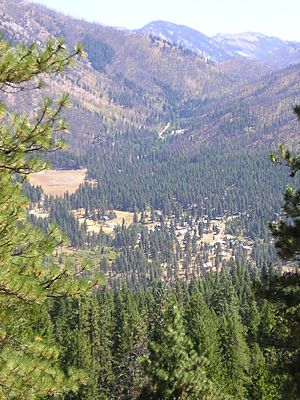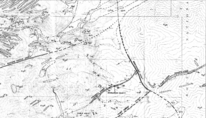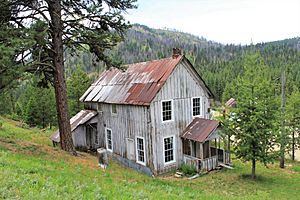Atlanta, Idaho facts for kids
Quick facts for kids
Atlanta, Idaho
|
|
|---|---|
 |
|
| Country | United States |
| State | Idaho |
| County | Elmore |
| Named for | Atlanta, Georgia |
| Elevation | 5,383 ft (1,641 m) |
| Time zone | UTC-7 (Mountain (MST)) |
| • Summer (DST) | UTC-6 (PDT) |
| ZIP code |
83601
|
| Area codes | 208, 986 |
| Website | atlantaidaho.net |
Atlanta is a small, unincorporated community in Elmore County, Idaho, in the western part of the country.
It was founded in 1864 during the Civil War. It started as a community for gold and silver miners. People from the South named it after a battle in Atlanta, Georgia, even though the news they heard about a victory was wrong. But the name stayed!
Gold was actually found near Atlanta just before the town was established. On July 20, 1864, the John Stanley group discovered gold on the nearby Yuba River. A few months later, in November, John Simmons found the "Atlanta lode," which had both gold and silver.
Contents
Exploring Atlanta's Location
Atlanta is located high up, at about 5,383 feet (1,641 meters) above sea level. It is surrounded by the beautiful Boise National Forest. The town is near the start of the Middle Fork of the Boise River. The Sawtooth Mountains are directly to the north. The Sawtooth Wilderness area begins just about a mile (1.6 km) north of Atlanta, at the base of Greylock Mountain. This mountain reaches a height of 9,363 feet (2,854 meters).
How to Get to Atlanta
Atlanta is quite remote, about 40 miles (64 km) from the nearest paved highways. You can reach it by taking unpaved U.S. Forest Service roads. One way is from State Highway 21 to the east. Another way is from U.S. Highway 20 to the south. This route takes you through small towns like Rocky Bar, Featherville, and Pine. You can also get to Atlanta by following an unpaved road from Arrowrock Dam, which goes along the Middle Fork of the Boise River.
Atlanta's History and Modern Life
Atlanta was originally a mining town. While some private mining claims still exist, there hasn't been much large-scale mining for over 50 years. However, there has been some recent interest in opening a new mining plant.
Today, Atlanta has changed. It now focuses on tourism, outdoor activities like hiking and fishing, and preserving its long history. In the summer, The Atlanta School offers workshops in arts and architecture. It also hosts artists who come to live and work there for a while.
The Atlanta Historic District is a special area that covers 10 acres (4 hectares). It includes 12 important historic buildings. This district was added to the National Register of Historic Places in 1978.
Gold Mining in Atlanta's Past
Gold was first discovered in the Atlanta area in 1863. Simple placer mining (washing gold from riverbeds) began along the Yuba River in 1864. The "Atlanta Lode" (a rich vein of ore) was found in November 1864. Soon after, other important lodes like Minerva, Tahoma, Last Chance, and Big were discovered. Mines such as Buffalo, Monarch, and General Pettit quickly developed. The Monarch Gold and Silver Mining Co. operated from 1866 to 1869.
Early Mining Methods
At first, miners used simple machines called Arastras to process the gold ore. They often ignored the silver. Early stamp mills also focused only on gold. Even when the "Washoe process" was introduced in 1869 at the Monarch mine, it only recovered about 20% of the valuable metals.
Lantis & Company took over the Monarch property in 1874. By 1877, the Buffalo mill was able to recover 55% of the metals. This success led to a building boom in Atlanta. The Buffalo mill and the Monarch mine together employed 60 people. The Atlanta community grew to 500 residents, and a road was built to Rocky Bar.
However, by 1884, most of the easily found, high-grade ore had been processed. By 1885, Lantis & Company had dug the Monarch mine shaft down to 600 feet (183 meters).
Modern Mining and Decline
In 1902, the Atlanta Mines Co. bought the Monarch Mine, and later the Buffalo and Last Chance mines. The company built a large mill that could process 150 tons of ore. This mill was connected to the mine by an aerial tramway (like a cable car system). It was powered by a hydroelectric plant west of Atlanta.
In 1932, the Saint Joseph Lead Company improved the way metals were recovered. They used a new process called amalgamation-flotation concentrator. This started a new era of modern production. In 1938, the Middle Fork road connected Boise with Atlanta, making access easier. Talache Mines, Inc., bought all the mining operations along the Atlanta Lode in 1939. However, mining operations eventually stopped in 1953. The Atlanta Gold Corporation of America acquired the lease in 1985.
Atlanta's population was 110 people in 1909, and it dropped to 50 people by 1960.
Climate in Atlanta
Atlanta has a climate with big changes in temperature between seasons. Summers are warm to hot, and sometimes humid. Winters are cold, and can be very cold. This type of climate is called a humid continental climate.






